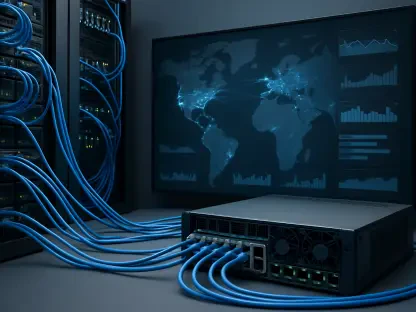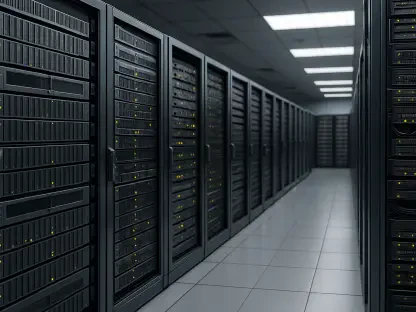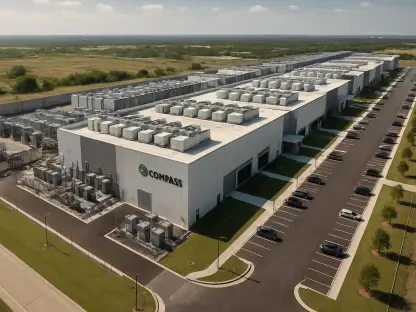The modern digital landscape is undergoing a transformative phase as businesses increasingly adopt edge computing in conjunction with multicloud strategies. Edge computing represents a significant shift away from traditional centralized data processing within cloud infrastructures toward processing data closer to its source. This change is crucial for industries that rely on rapid data collection and analysis, such as healthcare, manufacturing, and autonomous vehicles. In parallel, multicloud environments help businesses achieve greater control and flexibility over their operations. By utilizing a combination of cloud services, organizations can select the best options for various applications, ultimately innovating, scaling, and staying competitive.
Integrating Edge Computing and Multicloud Solutions
Understanding Edge Data Processing
Edge computing is revolutionizing the way industries manage large volumes of data, providing significant advantages over centralized systems. By processing data near its origin point—utilizing Internet of Things (IoT) devices like sensors and cameras—this approach reduces latency and enables more immediate responses. In manufacturing, for instance, localized processing facilitates predictive maintenance by identifying potential failures before they occur, thus minimizing downtime and optimizing productivity. Similarly, in healthcare, edge computing enables real-time patient monitoring, allowing medical professionals to make quicker, more informed decisions, ultimately improving patient care outcomes.
Furthermore, local data processing also alleviates the burden on bandwidth, as less information needs to be transmitted over long distances to centralized cloud locations. This advantage is especially beneficial in situations where continuous data streaming is necessary, or internet connectivity may be inconsistent. The ability to process data locally not only enhances system performance but also bolsters security by reducing the exposure of sensitive information during transmission. With the security and precision offered by artificial intelligence (AI) and machine learning, the implementation of edge computing is poised to transform operations across a multitude of sectors, paving the way for a more efficient and innovative future.
Multicloud’s Role in Business Operations
Adopting multicloud strategies offers businesses the flexibility to select optimal cloud services for different aspects of their operations instead of relying solely on a single cloud provider. This shift grants organizations the ability to tailor solutions to specific needs while maintaining seamless accessibility and security. The multicloud approach aligns with a proactive business strategy, empowering enterprises to leverage different infrastructures for application hosting, data storage, and advanced analytics. By diversifying their cloud portfolio, businesses reduce the risk associated with potential service disruptions, ensuring continuity and resilience.
Furthermore, employing multiple cloud services introduces valuable redundancy, providing organizations with additional layers of protection and safeguarding critical operations against unforeseen disruptions or cyber incidents. In essence, multicloud strategies facilitate robust business continuity plans, allowing operations to be more flexible and adaptable to change. As data privacy and compliance requirements evolve, businesses can be more discerning in selecting cloud providers based on specific security features and geographic restrictions. By strategically mixing cloud services, companies ultimately enhance agility, optimize costs, and maintain a competitive edge in the rapidly changing digital environment.
Unveiling the Benefits of Convergence
Merging Edge with Multicloud
The convergence of edge computing and multicloud strategies marks a pivotal evolution in digital infrastructure, presenting organizations with an enriched blend of capabilities. Edge computing enables real-time localized processing, reducing the dependency on central cloud infrastructures, while multicloud environments provide the redundancy and adaptability required to use various services according to particular business needs. This combined approach allows organizations to unlock superior performance metrics where the computational efficiency of edge computing is complemented by the versatility and reliability of multicloud deployments.
In manufacturing and logistics, the real-time data processing capability from edge infrastructures can be integrated seamlessly with multicloud environments. Businesses benefit from more precise tracking and automation, optimizing resource allocation and minimizing waste. Multicloud solutions ensure that these operational benefits remain consistent irrespective of changes in conditions or demands. Ultimately, this convergence offers businesses a scalable framework on which to build processes that are both resilient and dynamically adjustable, enhancing their ability to respond swiftly to market shifts without compromising operational downtime or data integrity.
Advantages of Combined Solutions
The fusion of edge computing with multicloud frameworks unlocks substantial benefits, markedly enhancing the resilience and flexibility of business operations. Reduced latency through local data processing optimizes bandwidth use and dramatic improvement in service response times. Edge computing’s ability to minimize transmission distances and process data at the source enhances the preservation of data quality, critical for applications demanding high accuracy such as financial models or health diagnoses. Additionally, integrating AI and advanced analytics further strengthens predictive capabilities.
Similarly, multicloud solutions enable organizations to effortlessly scale resources in line with fluctuating demand, ensuring disruptions are minimized. This flexibility is paramount across sectors with variable workloads or seasonal peaks. With multicloud infrastructure, businesses can balance workloads across different cloud services without encountering bottlenecks. Further, by diversifying cloud engagements, organizations mitigate risks linked to vendor lock-in, fostering a robust marketplace with increased negotiation leverage and improved service offerings. These combined advantages create a strong foundation for modernizing business processes, turning challenges into opportunities for growth and innovation.
Addressing Security and Compliance Challenges
Mitigating Cybersecurity Risks
As businesses adopt more decentralized computing models through edge and multicloud strategies, there is an increased focus on addressing security and compliance challenges. Edge devices, often situated outside traditional security perimeters, introduce vulnerabilities that require thoughtful mitigation strategies. Enterprises must implement robust security measures, including encryption, network segmentation, and access control protocols, to safeguard sensitive data. Furthermore, the complexity of maintaining security across diverse multicloud environments necessitates advanced threat detection and response capabilities, often powered by AI-driven analytics.
Effective cybersecurity strategies rely on continuous monitoring and analysis of potential threats, ensuring threats are detected early, preventing breaches or data loss. Organizations must invest in comprehensive cybersecurity frameworks to enable timely identification and response to incidents. By collaborating with security partners and employing cutting-edge technology, businesses can protect their infrastructure against evolving threats. Furthermore, as regulations governing data privacy become increasingly stringent, companies must ensure compliance across various jurisdictions, adapting policies to meet specific regional requirements, thus safeguarding trust and reputation.
Navigating Compliance Demands
In tandem with cybersecurity efforts, businesses must navigate the complex landscape of regulatory compliance, which is integral to successful edge and multicloud integrations. Compliance with region-specific data handling requirements demands meticulous attention to storage, transmission, and processing practices. Organizations must implement protocols and tools that provide transparency and auditability, ensuring data practices adhere to applicable laws and standards. Using multicloud strategies that incorporate regional data centers helps businesses address these challenges effectively while leveraging the strengths of diverse cloud providers.
To address compliance concerns, businesses should establish dedicated teams responsible for overseeing data governance and regulatory adherence. This approach not only facilitates compliance but also strengthens partnerships with stakeholders, demonstrating commitment to ethical and lawful practices. Additionally, collaborating with channel community partners to align cloud services with industry best practices can provide firms with invaluable insight and guidance. By approaching compliance as an opportunity rather than a constraint, organizations can maximize operational efficiency while embracing innovation confidently.
The Channel Community’s Influence
Empowering through Partnership
The role of channel community partners in facilitating the integration of edge computing and multicloud strategies is invaluable. These partners offer an extensive knowledge base and technical expertise, aiding businesses in identifying solutions tailored to specific requirements. As organizations navigate complex technological transitions, channel community partners provide critical support, advising on strategic decisions and contributing to seamless integration of innovative solutions. Their assistance proves essential in empowering enterprises to embrace change effectively while ensuring solutions are aligned with business goals and long-term visions.
Channel partners are instrumental in translating advanced technologies into actionable strategies that benefit organizations. By closely collaborating with clients, they gain an intimate understanding of unique challenges and opportunities, fostering innovation through collaborative problem-solving. Additionally, their ability to recommend technologies suited to specific operational needs prevents mismatches that could hinder long-term success. Through synergy and shared expertise, channel community partners inspire confidence and drive successful implementations, ensuring businesses are equipped to adapt and thrive in the ever-evolving technological landscape.
Future-Proofing Business Strategies
Beyond immediate integration benefits, channel community partners play a key role in future-proofing business strategies by anticipating industry trends and aligning solutions accordingly. Their insights allow organizations to remain agile and responsive to emerging challenges, safeguarding competitiveness in a dynamic marketplace. With their help, businesses can proactively identify potential disruptions and technological advancements that may impact their sectors, adapting accordingly to mitigate risks and harness new opportunities. This forward-thinking approach stands at the heart of crafting sustainable, innovative strategies.
Looking ahead, the channel community’s involvement is crucial in fostering beneficial partnerships and ensuring technology serves as a catalyst for progress. By facilitating education and training initiatives, channel partners equip businesses with the tools and knowledge necessary to navigate transformation with confidence. Their commitment to continuous improvement enables companies to maximize returns on technology investments and remain at the forefront of industry advancements. Together, businesses forge new paths, capturing opportunities that not only future-proof operations but also elevate standards of service and performance.
Strategic Implications and Opportunities
Driving Transformational Change
The integration of edge computing and multicloud strategies signifies a new era in digital transformation, offering businesses unparalleled opportunities to innovate and excel. As industries continue to explore edge-enabled solutions, the potential to optimize existing processes while undertaking novel initiatives grows exponentially. For sectors heavily reliant on data-driven decision-making, this combined approach cultivates environments ripe for growth. Automation, data localization, AI enhancements, and scalability furnish incredible avenues for expansion, allowing businesses to explore creative paths and set new benchmarks for operational excellence.
More than enhancing operational efficiency, merging edge with multicloud fosters cultural shifts that embrace innovation across organizations. This transformation encourages departments to collaborate on projects that stimulate creativity, ultimately driving competitive advantage. As more sectors harness these technologies, they discover unanticipated insights leading to better problem-solving and decision-making. Richer datasets and rapid processing, supported by multicloud infrastructure, accelerate the conversion of raw data into actionable intelligence. This continual quest for improvement extends the reach of businesses, enabling them to influence markets, create positive impacts, and spearhead industry shifts.
Long-term Strategic Vision
Effective integration of edge computing and multicloud does much more than enhance operational performance; it also anchors long-term strategic vision. By fostering resilience and continuous adaptability, organizations become empowered to explore new markets, enhance product offerings, and innovate more sustainably. This combination of technologies renders organizations more versatile in devising strategies aligned with future trends, ensuring seams between development and delivery remain robust and flexible. Eying the future, businesses can leverage pioneering technologies to create novel products and partnerships, extending their market reach and increasing revenue streams.
Enhancements in capabilities accumulate significant benefits over time, forming a roadmap for sustained competitive positioning. With growing demands and rapidly shifting environments, such strategic foresight equips businesses to tackle industry challenges efficiently. Planning with an eye on the future nurtures businesses to tackle industry challenges efficiency. Planning with an eye on the future nurtures businesses to tackle industry challenges efficiently.
Conclusion: Embracing Technological Transformation
The modern digital landscape is undergoing a transformative phase as businesses increasingly adopt edge computing in conjunction with multicloud strategies. By processing data close to its source, edge computing shifts away from traditional centralized data processing. Multicloud environments offer enhanced control and flexibility, allowing businesses to select the best services for their needs, driving innovation, scalability, and competitiveness. This convergence enables businesses to adapt swiftly to technological changes, ensuring they remain at the forefront of their industries.









